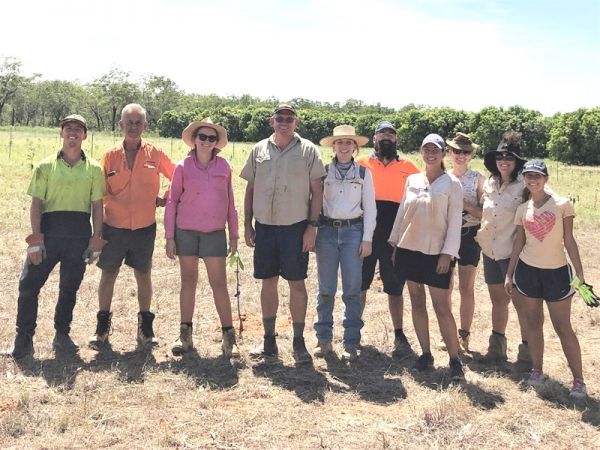Growers trial high density mango systems
Australian mango growers in partnership with the Department of Agriculture and Fisheries (DAF) and Australian Mangoes, have planted new, high density mango blocks as semi commercial trials on three properties in Queensland and the Northern Territory this year. (2019)

Katherine planting crew
The trials are key components of the three-year project ‘Transforming Mango Futures’ funded through the Cooperative Research Centre for Developing Northern Australia (CRCNA). This project aims to facilitate increased mango grower adoption of next-generation, intensive mango systems to help improve the productivity and profitability of the Australian mango industry.
Project lead Dr Geoff Dickinson from DAF at Mareeba, Queensland said, “These systems have shown great promise to significantly increase the quantity and quality of mango fruit yields within DAFs on-going ‘Small Tree High Productivity Initiative’. Added benefits from these systems include adaptation to automation and robotics, improved input efficiencies and greater cyclone resilience.”
The three trials comprise a variety of four ‘best-bet’, intensive mango orchard systems including high-density and trellis designs, planted using the current commercial mango varieties Kensington Pride (KP) and R2E2, and two new mango varieties NMBP1243 and NMBP4069. Each trial is 0.5 hectares in size.
Two of these trials were established with Manbulloo Ltd, one of Australia’s largest growers and exporters of KP and R2E2 mangoes, on their properties at Mareeba and Katherine.
The third trial was established with Marto’s Mangoes, a large R2E2 mango grower and exporter, at their Bowen property.
The trees were planted at a spacing of 3m between trees and at either 5 or 6m between rows, to suit existing farm machinery access. This gives a tree density of between 555-666 trees/hectare. The infrastructure for the trellis treatments involved 15cm diameter H5 Koppers Logs established 12m apart and supporting five trellis wires spaced 60cm apart up to a height of 3.1m. Trellis treatments will be managed using espalier or palmate branch training/pruning techniques.
The non-trellis treatments will be managed using conventional (open vase) or single leader branch training/pruning techniques. All trees will be maintained to a maximum height of 3.5m.
The Mareeba and Bowen sites were planted in February and March, with the Katherine site established in April. At each site the trellis posts and wire were constructed after tree planting.
“The trees were topped at 65cm after planting, to allow the development of the first whorl of branches for training,” said Dr Dickinson.
“These trees began re-shooting after three months, and we have started training these new shoots onto the trellis wires using rubber ties.”
Project communication activities are being co-ordinated by DAF and Australian Mangoes. New hard-copy and video training packages will identify scaling-up and transition issues, backed by an economic analysis to aid orchard transition. Mango growers had a first-hand opportunity to visit the Manbulloo Mareeba site at the August pre-season roadshow event.
This CRCNA project will create impact for national industry growth in northern Australia, driving productivity improvements, industry resilience and enabling the growth of existing and new domestic and export markets.
For more information contact DAF Development Horticulturists; Geoff Dickinson geoff.dickinson@daf.qld.gov.au or Ebony Faichney ebony.faichney@daf.qld.gov.au.